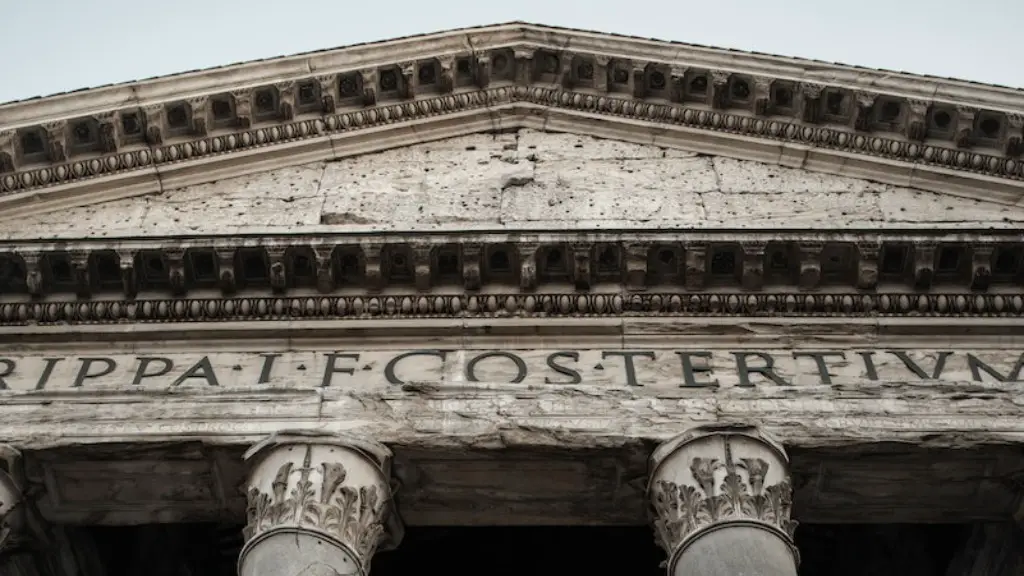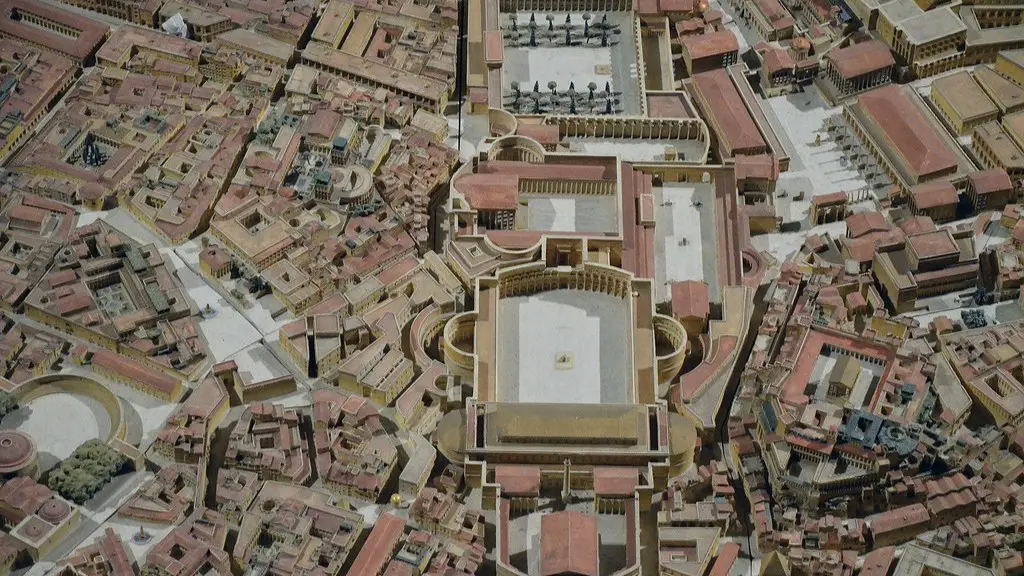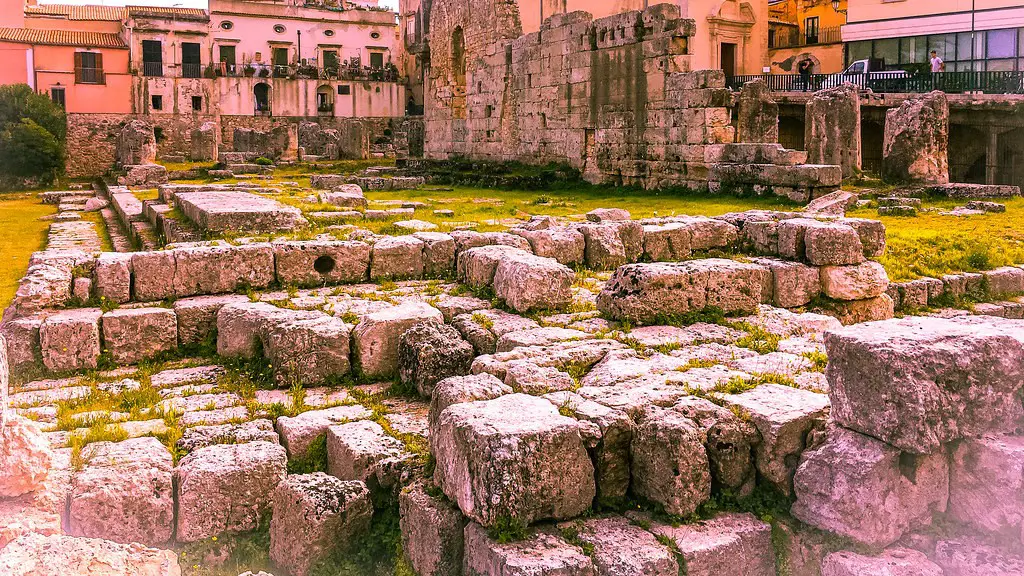Religion held a central place in Ancient Rome, as it was the foundation upon which Roman culture and politics were built. Roman religion did not have a unified canon of religious beliefs and practices, but it was primarily polytheistic and involved a variety of different gods, festivals and rituals. In general, Ancient Rome was a deeply religious society, and religion was regarded as a fundamental part of both public and private life.
According to tradition, Rome was founded in 753 BC by Romulus and Remus, two brothers who were considered to be divinely fathered by the war god Mars, who reigned over the city. The Roman pantheon was drawn from many sources, including Etruscan, Greek and local Italian gods. The most important gods and goddesses in the Roman pantheon included Jupiter, Juno and Minerva, who presided over the law and senate; Mars, who was the god of war; Apollo and Diana, who represented the sun and the moon; and Mercury, who presided over trade and communications.
Religion was deeply intertwined with Roman politics, and the power of the Roman state was often linked to religious authority. Every year, public ceremonies were held to honour the gods, as well as to honour the emperor as the divinely-ordained head of state. Popular cults dedicated to specific gods also developed, such as the Cult of Mithras, which was popular among Roman soldiers. Religious ceremonies such as sacrifices of animals to the gods, as well as festivals and games, were common among the Roman people.
Religion in Ancient Rome also affected the everyday life of the people. Many Roman households kept a shrine to the gods or a “lararium,” and placed images of gods in it. Priests were consulted for advice and divination, and sacrifices were sometimes made at the home shrine to bless the family and protect them from illness or misfortune. Religion was also used in the administration of justice, as the gods were associated with justice and the law.
Though Roman religion was highly diverse and often contradictory, it was deeply embedded in Roman culture and politics. It influenced the laws, the values, and the daily lives of the people, and it played an important role in uniting a sprawling and diverse empire.
Ancient Roman Religious Practices
Roman religion was a complex system which included a variety of different practices. The most important religious practices included sacrifices, prayers, libations, votive offerings, processions, and the use of sacred objects such as amulets, talismans and figurines. Sacrifices of animals, wine and grain were offered to the gods as an expression of reverence and gratitude. Prayers were used to solicit the help and protection of the gods, and votive offerings were given as a token of devotion or as an offering of thanks. Processions, which were often accompanied by music and dancing, were used to mark important events such as Harvest festivals and other religious holidays.
Sacred objects, such as amulets, talismans and figurines, were believed to be imbued with the power of the gods and were sometimes used to bring good luck or ward off evil. Special rituals such as consecrations, the use of prophetic dreams and augury, and the practice of consulting fortune tellers, diviners, and sorcerers were also common in Roman religion.
Ancient Roman Religious Structures
The Roman religion was made up of a vast array of deities and gods, and religious structures were designed to honor them. Major temples were known as Aedes, or “houses” of the gods, and were often positioned near a source of water or a hilltop. Temples were often dedicated to a specific god or gods, and were also used to house shrines, cult altars, and statues of the gods.
The Roman Pantheon, a large temple which housed the most important gods and goddesses, was completed in the year 126 AD. Marble statues lined the entrance of the Pantheon and a central area was laid out and covered in marble to honor the gods. The temple was dedicated to the worship of the gods and was used to conduct elaborate ceremonies, processions, and public sacrifices.
In addition to temples, Ancient Rome also had two important religious regulatory bodies: the Ambuencia and the Senate. The Ambuencia was a religious council which supervised religious observance and the performance of public sacrifices, and the Senate was responsible for the administration of religion and the granting of licenses for religious rituals.
Influence of Ancient Roman Religion
Ancient Rome’s religion was a major influence on both Roman culture and politics. Religion was used to legitimise the power of the emperor and it played an important role in maintaining the unity of the Roman Empire. Although Christianity eventually supplanted Roman religion, its legacy persists in the Roman Catholic Church, which still claims the authority of the Roman emperors as its own. Roman religious institutions, such as the priesthood and the vestal virgins, also have deep roots in Ancient Rome. Furthermore, many Roman gods and goddesses have been appropriated by other cultures, and ideas such as ancestor worship, votive offerings, and the concept of divine privilege have survived to the present day.
Decline of Ancient Roman Religion
The decline of Roman religion began during the decline of the Roman Empire in the 4th and 5th centuries AD. By this time, Christianity was firmly established as the official religion of the Empire, and Roman religious practices were replaced or blended with Christianity. In 374 AD, the emperor Gratian issued a decree which placed Christian bishops in charge of Roman priests, and although Roman worship was still practised for some time, it eventually fell into disuse.
The decline of Roman religion was accompanied by a decline in Roman superstitions and rituals. People began to abandon traditional religious festivals and gods in favour of Christianity, and the classical gods were largely forgotten. Roman religion was also damaged by the rise of critical and scientific thought, as well as by the endemic political instability and economic decline of the late Empire.
Legacy of Ancient Roman Religion
Although Roman religion has largely been forgotten, its legacy can still be seen in the modern world. Roman religious symbols, such as the toga, the laurel wreath, and the eagle, have been adopted by many governments and societies, and aspects of Roman religion can still be found in modern-day Italy, such as the practice of ancestor worship. Roman gods and goddesses, such as Jupiter and Juno, are still worshipped in some areas, and the influence of Ancient Rome can be found in the Roman Catholic Church, which has become the largest Christian denomination in the world.
Conclusion
Ancient Roman religion was a complex and diverse system which played an important role in the political, cultural and social life of the Roman Empire. It was a polytheistic religion made up of a vast array of gods and goddesses, and its influence can still be seen in modern-day societies and religions.



